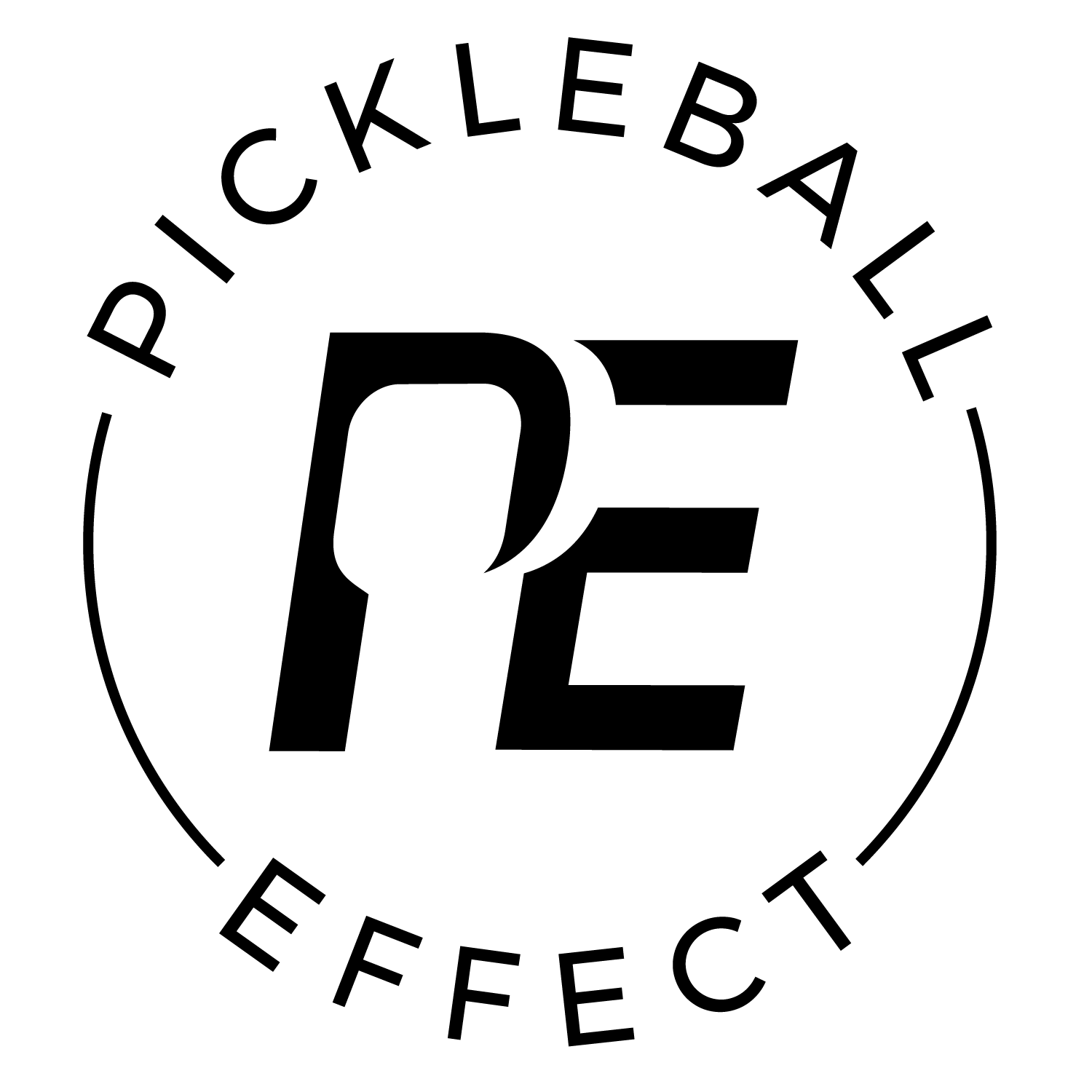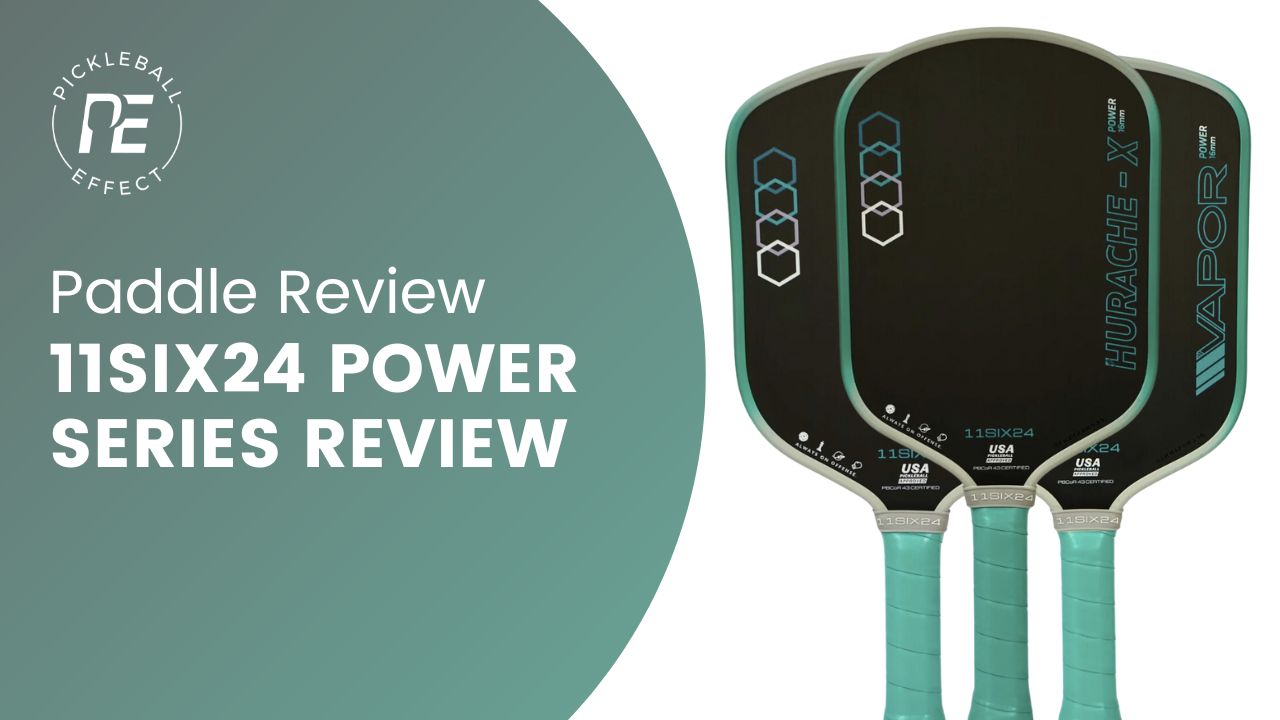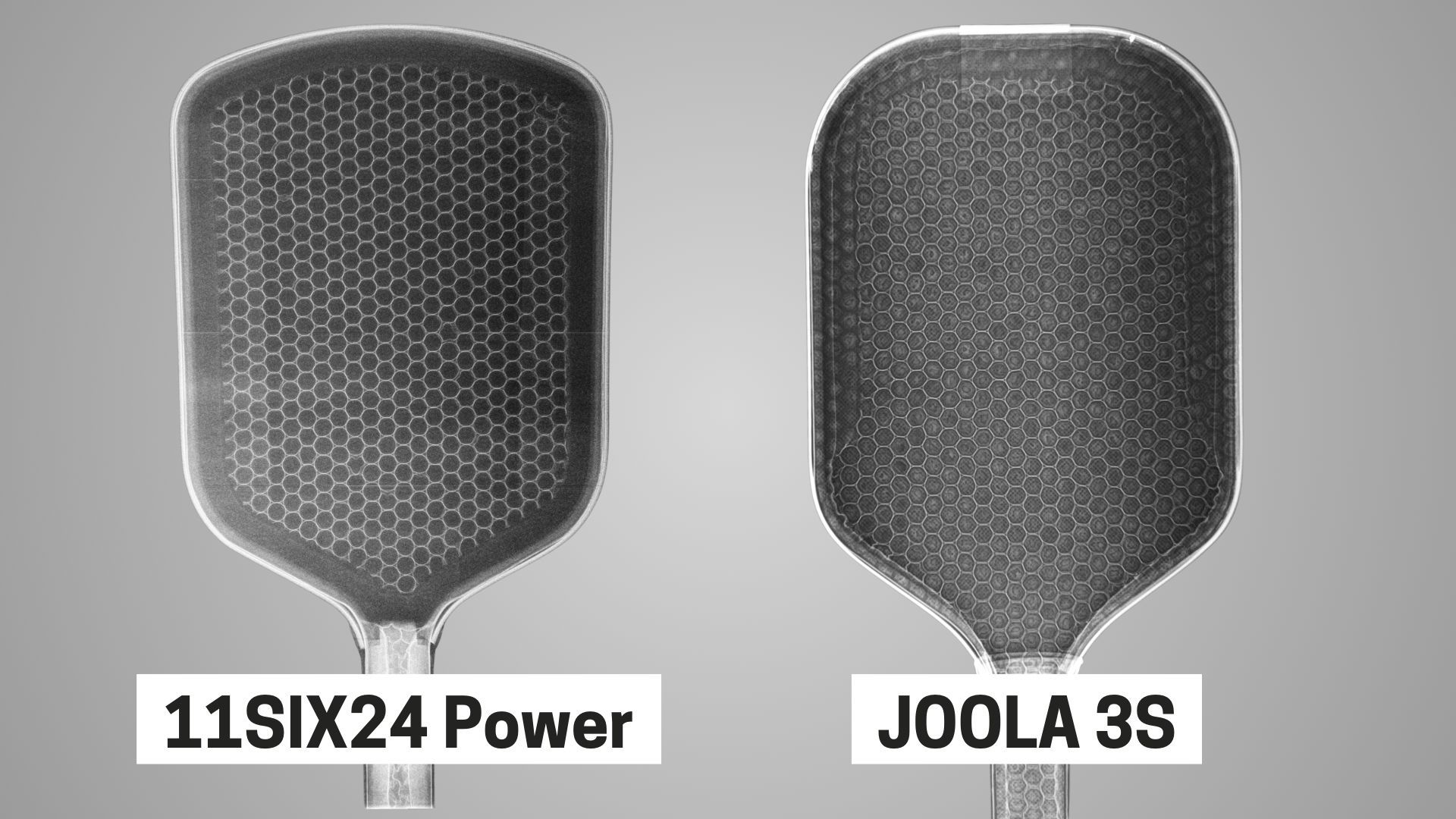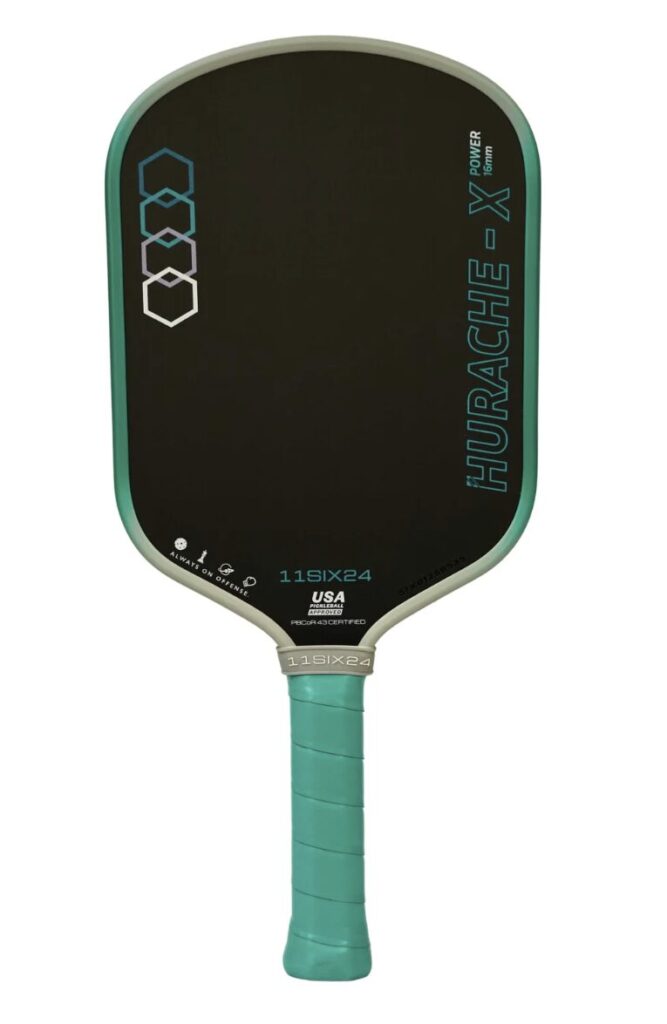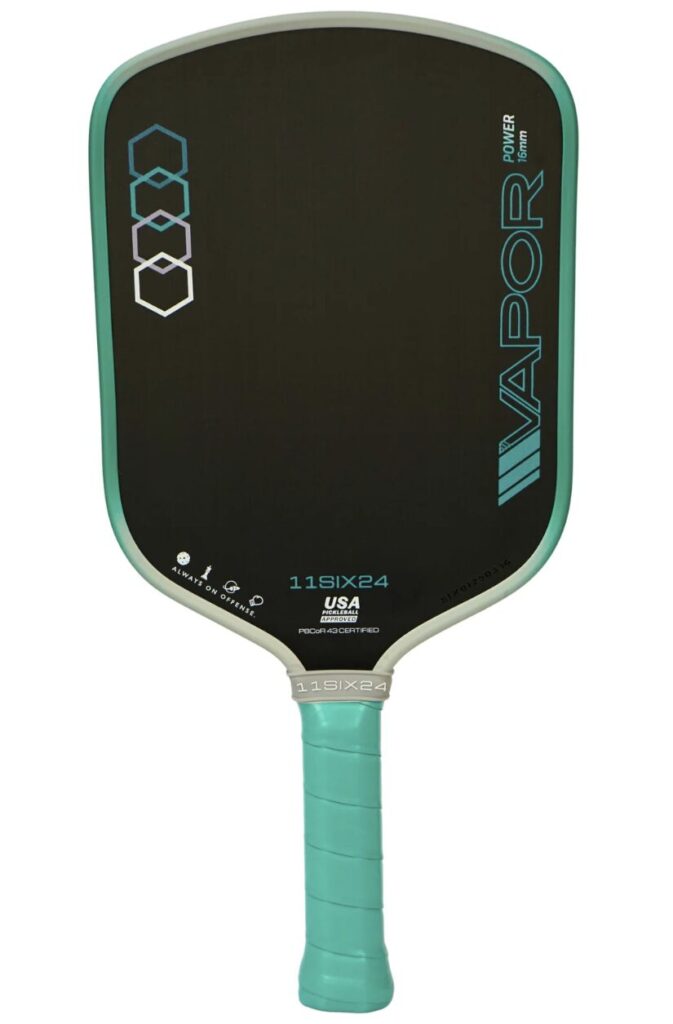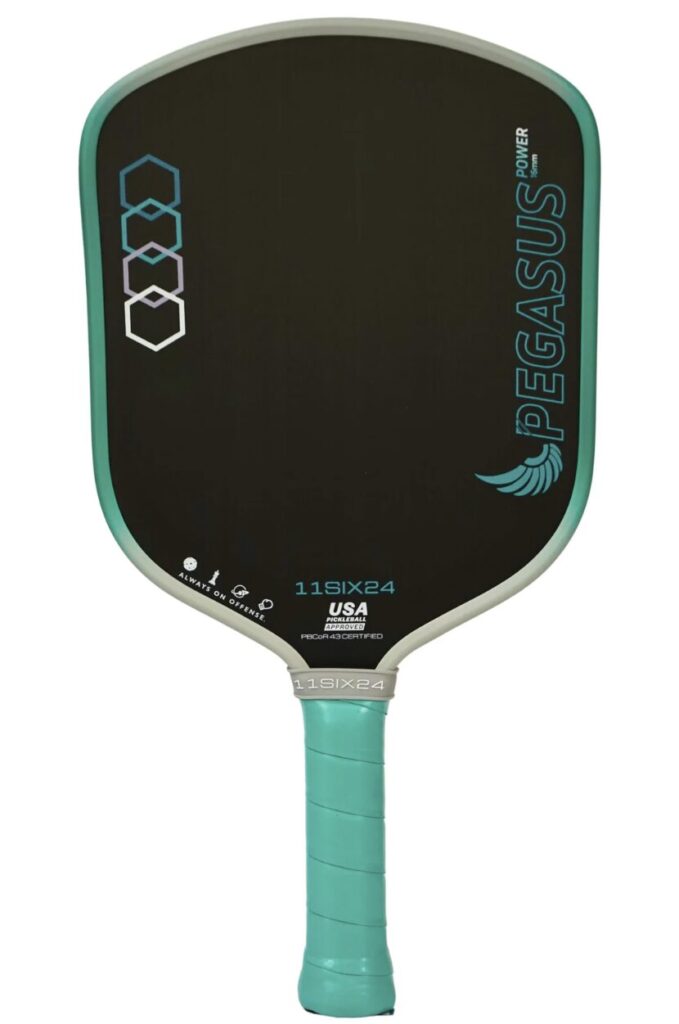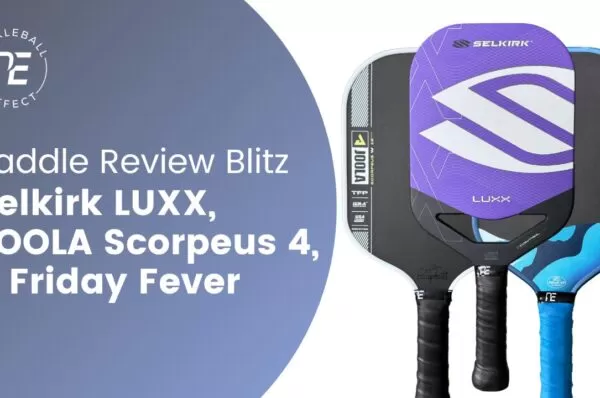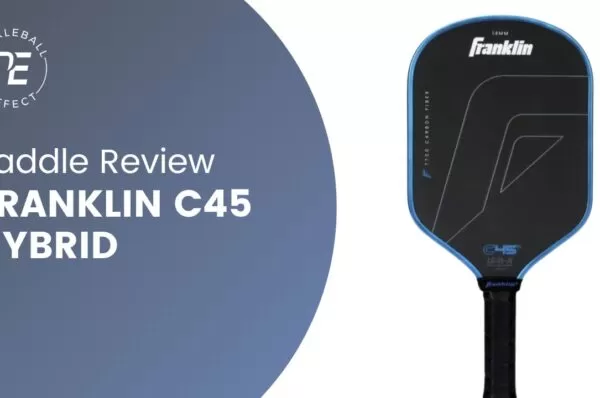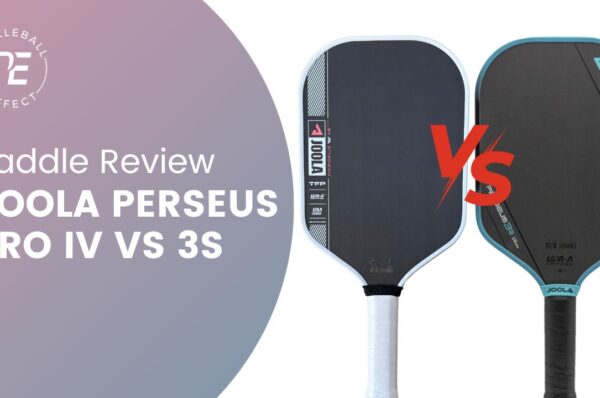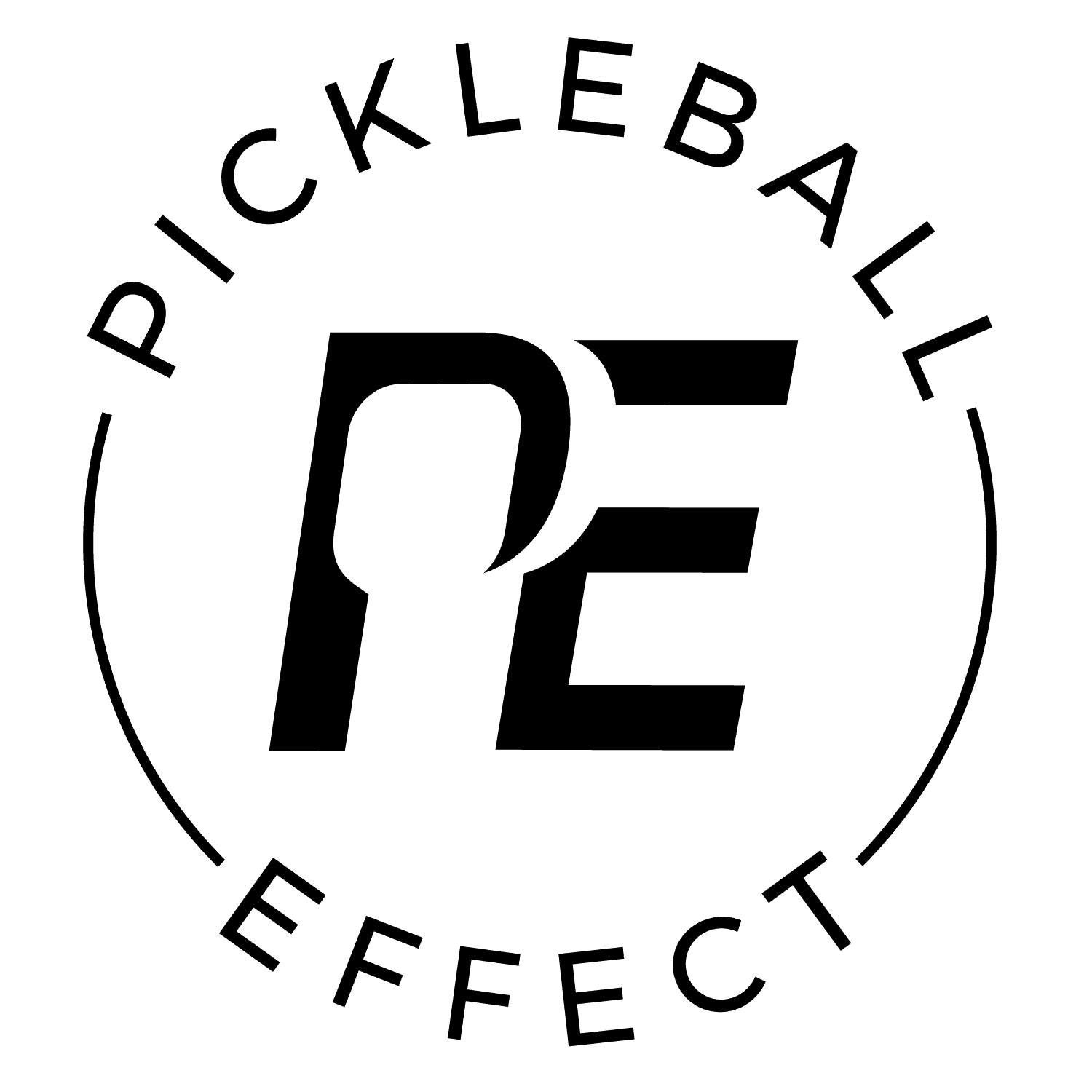Power doesn’t have to equal wild, uncontrolled shots. The 11SIX24 Power Series delivers on that. Offering more controllable power with a forgiving and user friendly design, these are built for the everyday player seeking more power.
Today we’re reviewing and looking at the 11SIX24 Power series. This is their take on a gen three style paddle. The series is available in three shapes all of which are 16mm thick. For this review I’ll look at the paddle construction, overall performance of the series, and finish with a brief review of each shape.
If you find my review helpful and decide to purchase one of these paddles, please use my code PBEFFECT on 11SIX24’s website. This will give you a discount and support my review efforts. Thanks to 11SIX24 for sending me these paddles; however, this article is not sponsored, and all opinions are my own. Let’s dive in.
(Get $10 off with the discount code PBEFFECT on 11SIX24’s website)
Table of Contents
11SIX24 Power Series Construction Explained
The 11SIX24 Powers utilize a Gen 3 style build with widened foam around the perimeter and is thermoformed. Two primary Gen 3 construction styles have emerged over the last six months: the floating core method (11SIX24 Power) and the diving board style method (JOOLA 3S Series).
Floating Core: Widened foam surrounds the entire core and separates it from the handle, as seen in the x-rays. Brands use varying amounts and sometimes two types of foam. This style adds power, but not as much as the Diving Board Style.
Diving Board Style: A second foam layer covers only the top two-thirds of the paddle, not the entire head, nor does it separate the polymer from the head to the handle (see JOOLA 3S x-ray). Foam levels vary by brand. In my experience, this style generates the most power and pop.
11SIX24 chose the floating core design with only one foam type. Additionally, the 11SIX24 x-ray shows white strips on the polymer core’s sides, indicating perimeter weighting to improve the sweet spot. Lastly, you can see in the x-ray that 11SIX24 is using larger cell sizes in their core which is also known for adding power and pop.
11SIX24 Power Series Performance Review
This section will provide a general overview of the series, and the sections that follow will detail the performance nuances of each shape.
Power & Pop: These paddles have a moderately high power and medium pop profile, playing like all-court paddles until activated with bigger strokes and added force. Initially, they didn’t feel like power paddles, but their top-end power became more apparent and the pop subtly increased as they broke in. This power does need to be activated; they don’t generate as much ball speed on their own as paddles like the Paddletek Bantam or JOOLA 3S. I’ve played several control-style paddles with this activation aspect for increased all-court offense, but not many that seamlessly transition between all-court and power play like these.
If you’re coming from an all-court style paddle you’ll notice the bump in offense but it won’t be dramatic. And if you can’t generate much power on your own then you may wonder where the power is on these. It takes some effort to find it.
Control & Feel: Because the paddles had medium pop, they were more controllable compared to paddles that have more immediate power. I never felt like the ball was jumping away from me unexpectedly or was surprised when I hit a ball long. They do have more pop and spring to them than a control paddle, so you need to do some of the work to slow the ball down yourself when you’re stretched out or under pressure, but I never felt out of control or thought they were difficult to dial in. The Floating Core design creates a more consistent and predictable face play than the Diving Board design. The Diving Board design’s higher power results in a noticeable power drop-off when hitting lower on the face.
The paddle’s impact feel is semi hollow. It’s not as hollow of a feel as the JOOLA 3S series, though it’s not as dense feeling as a traditional thermoformed paddle—it’s somewhere in between those. It felt good to me, though it wasn’t a draw or setback of the paddle. Overall, I don’t think you have to be a 5.0 player to dial these in.
Forgiveness/Sweet Spot: This area is a strength for this series. Every shape had an oversized sweet spot compared to paddles with similar designs. Plus, the power and pop levels were more consistent across the sweet spot compared to Diving Board style gen 3 paddles.
Maneuverability: These paddles have higher than average static weights, but their swingweights are typical for their shapes. Due to the slightly higher static weights, the paddles feel a bit heavier in-hand than their swingweight suggests. However, this difference is minimal and manageable. The benefit is that the paddles are forgiving and don’t need weight customization to play well out of the box. This way you don’t need to add weight and sacrifice maneuverability in an effort to improve stability and power by adding weight.
Spin: Spin tests on these paddles were excellent, as is the case with most modern paddles. Spin isn’t as much of a differentiating factor as it used to be.
(Get $10 off with the discount code PBEFFECT on 11SIX24’s website)
11SIX24 Power Review by Shape
While the above section was meant to give you the general idea of the 11SIX24 Power series as a whole, this section will give you a more detailed look into the nuances and numbers of each paddle in the series.
The series is offered in three different shapes that were designed and are unique to 11SIX24 though they fall into your typical categories of elongated (Hurache-X), hybrid (Vapor), and widebody (Pegasus). Each paddle in the series is 16mm thick and has longer handles.
Hurache-X Power
- Approval Body: USAP PBCoR .43 Approved
- Static Weight: 8.2 oz avg
- Swingweight: 116-119 (moderately high)
- Twistweight: 6.4 (moderate)
- Spin RPMs: 2033 (very high)
- Length x Width: 16.5″ x 7.5″ (elongated)
- Face: CFC Carbon, Fiberglass, Carbon
- Grip Circumference: 4.125″
- Handle Length: 6″
- Core: 16mm polypropylene
- Paddle Type: Power
- Price: $169.99 ($159.99 with code PBEFFECT)
- Warranty: 6 month warranty & 30 return policy with 25% restocking fee for used items – learn more
(Get $10 off with the discount code PBEFFECT on 11SIX24’s website)
This shape has the highest top-end power in the series and is one of the best elongated paddles I’ve used recently. Elongated paddles tend to be more head-heavy and less forgiving, but this one maintained a manageable swingweight of around 118 while still providing a good twistweight measurement of 6.4. If you’re accustomed to elongated paddles then you’ll think this one moves pretty easy and plays forgivingly. 11ISX24 seems to have intentionally made the static weight a little lower on this one compared to the other two shapes to avoid the swingweight getting too high.
11SIX24 made the handle on this one longer at 6” compared to the 5.75” handle lengths on their other shapes. This extra-long handle of 6” is a generous measurement. Other manufacturers might measure this at 5.75” so it didn’t feel so long that it took away meaningful paddle surface area, but if you’re not a fan of longer handles, then it will be too long for you.
Vapor Power
- Approval Body: USAP PBCoR .43 Approved
- Static Weight: 8.2 oz avg
- Swingweight: 114-117 (moderate)
- Twistweight: 7 (very high)
- Spin RPMs: 2085 (very high)
- Length x Width: 16.15″ x 7.75″ (hybrid)
- Face: CFC Carbon, Fiberglass, Carbon
- Grip Circumference: 4.125″
- Handle Length: 5.75″
- Core: 16mm polypropylene
- Paddle Type: Power
- Price: $169.99 ($159.99 with code PBEFFECT)
- Warranty: 6 month warranty & 30 return policy with 25% restocking fee for used items – learn more
(Get $10 off with the discount code PBEFFECT on 11SIX24’s website)
This is their hybrid shape, but it’s a different take. I define a hybrid shape paddle as having a total length longer than 16″ and shorter than 16.5″. Most hybrids are 16.25″ long, but this one is a touch shorter at about 16.15″ long. It’s very close to a widebody design, which I define as anything 16″ or shorter in length. Going a little shorter like this allows for a little more width, which combined with their extra perimeter weighting, gives this paddle a higher twistweight than other hybrid shapes.
I’ve seen others say that this paddle plays like an elongated paddle because they think the sweet spot is higher on the face, but I don’t entirely agree. I think it still moves and plays like a hybrid paddle, though it’s close in design to a widebody. This means you feel the extra reach without giving up much forgiveness—in this case, you give up none. However, it doesn’t play like an elongated paddle to me.
It is heavier than most hybrid paddles, with a swingweight around 116 instead of the typical 114. Then its average weight is close to 8.3oz instead of your typical 8oz. However, the trade-off is extra forgiveness, and you won’t need to customize it with tungsten tape to optimize performance. If I had a hybrid paddle with a swingweight around 112, I would probably add weight to reach a swingweight of approximately 115-116 anyway.
Pegasus Power
- Approval Body: USAP PBCoR .43 Approved
- Static Weight: 8.2 oz avg
- Swingweight: 109-112 (low)
- Twistweight: 7.5 (very high)
- Spin RPMs: 2085 (very high)
- Length x Width: 15.8″ x 8.12″ (widebody)
- Face: CFC Carbon, Fiberglass, Carbon
- Grip Circumference: 4.125″
- Handle Length: 5.5″
- Core: 16mm polypropylene
- Paddle Type: All-Court
- Price: $169.99 ($159.99 with code PBEFFECT)
- Warranty: 6 month warranty & 30 return policy with 25% restocking fee for used items – learn more
(Get $10 off with the discount code PBEFFECT on 11SIX24’s website)
This is their widebody shape and is the only shape in the series I wouldn’t consider a power paddle. I’d say it’s more of an aggressive all-court paddle. The Floating Core technology didn’t manifest itself with as much power in this shape as it did with the longer shape designs.
I didn’t find it terribly different in performance compared to 11SIX24’s Pegasus All Court. Though it has a touch more top end power than the All Court model, it largely plays very similar to it and so you might as well save a few bucks and get the All Court model.
If you’re okay with that profile of paddle in this shape then great, this is still a good paddle. However, if you want a true power paddle in the widebody shape then I’d recommend the Paddletek ESQ-C 12.7.
My Recommendation
The paddle’s excellent out-of-the-box playability, approachable power, good forgiveness, and multiple shape options make it attractive to a wide range of players seeking more power. It is a great option for players transitioning from a control paddle to a power style paddle, or for those playing with an all-court paddle and wanting a small bump in offense without losing control. If you’re already playing with a power style paddle, you might consider switching to this one for more forgiveness, but this will likely result in a trade-off in offensive ability, mainly pop. If you want a power paddle in a widebody shape, consider the JOOLA 3S and Paddletek ESQ paddles instead. Additionally, if high maneuverability is a priority for you, or you want as much pop as possible, you might also look elsewhere.
(Get $10 off with the discount code PBEFFECT on 11SIX24’s website)
Braydon competes at the 5.0 level and plays in 5-10 tournaments a year. He plays/drills 3 to 4 times a week and would play more if time allowed it.

Paddle Terms Glossary
We’ve categorized paddles into three categories. Control, All-Court, and Power. Paddle categories are determined by Braydon after he hits or reviews the paddle.
- Control paddles offer a softer feel and better absorbs pace off the ball but doesn’t give you as much power.
- All-Court paddles give you a blend of power and control and does well at everything though it doesn’t excel at anything.
- Power paddles often have a firmer feel and will return more power but are harder to control.
A paddle’s weight represents the inherent mass of the paddle as measured on a scale. However, relying solely on this static weight measurement can be misleading when assessing the true perceived heaviness of the paddle. Even if two paddles both clock in at 8 oz, their actual heft in your hand can markedly differ due to variations in weight distribution within the paddle. This is why the static weight should be considered with the swingweight of the paddle. See the definition of swingweight below.
The weight value listed in the database corresponds to the paddle’s weight that I used to gather the swingweight and twistweight measurement. It’s possible that if your paddle has a different static weight than then the swingweight and twistweight may be slightly different.
There are three primary shapes a paddle can have which consists of the length and width of the paddle. These three shapes are:
- Elongated: The dimensions for an elongated paddle are 16.5″ x 7.5″.
- Standard: A standard shaped paddle has dimensions of 16″ x 8″.
- Hybrid: A hybrid shaped paddle falls somewhere in between the standard and elongated shapes, with approximate dimensions of 16.25″ x 7.5″-7.7″.
Then there are two less common shapes you’ll see. These are:
- Extra-Elongated: This shape is 17″ x 7″
- Widebody: This any paddle shorter than 16″ long.
When considering the advantages and trade-offs of paddle shapes, it’s important to understand the characteristics of each shape.
- Elongated Paddle: An elongated paddle offers increased reach, spin, and power. However, this additional reach comes at the expense of forgiveness, particularly from side-to-side.
- Standard Paddle: In contrast, a standard-shaped paddle provides less reach and a little less power & spin but offers greater overall forgiveness. This means that while you may not have the same extended reach as an elongated paddle, you gain better control and stability.
- Hybrid Paddle: The hybrid shape serves as a middle ground between the elongated and standard shapes. It provides a balance between reach and forgiveness, offering players a versatile option that combines aspects of both shapes.
It’s interesting to note that advanced players often prefer elongated shapes. On the other hand, players at lower skill levels typically opt for the extra forgiveness offered by standard shaped paddles.
Ultimately, the choice of paddle shape depends on an individual’s playing style, preferences, and skill level. Whether your focus is on reach or forgiveness, understanding the unique benefits and trade-offs of each shape can assist you in selecting the paddle that best suits your game.
Swingweight is a measure of the paddle’s resistance to swinging about the end of the handle. The higher the swingweight number the heavier it will feel in your hands. A higher swingweight has more power but is harder to swing, lower swingweight is easier to swing but has less power. Sometimes a faster swing with a lower swingweight can make up for power lost in swingweight. The price paid for that is greater impact shock. Stock swingweights will vary between 100 – 140.
Twistweight is the resistance to rotating around the long axis through the middle of the paddle from butt to tip. The higher the twistweight the more resistance the paddle has to rotating on off center hits. This measurement is closely related to the amount of forgiveness or the size of the sweet spot of the paddle. A higher twistweight indicates a bigger sweet spot. Twistweight numbers range from 5 – 8.
Measuring the revolutions per minute (RPMs) off of a serve you get a number that shows the spin potential of a paddle. Using these RPM measurements I’ve created five buckets that a paddle will fall into indicating its overall spin potential. The five buckets are:
1900 or Higher = Very High
1700 – 1900 = High
1500 – 1700 = Medium
1300 – 1500 = Low
1300 or less = Very Low
You can tell a big difference in the amount of spin a paddle generates when you compare a Very High paddle to a low paddle. But the gains from Medium to High to Very High are marginal. We’ve found that having at least a medium rating is often enough if you’re looking for a good spin paddle. However, if you’re a big hitter then you will benefit more from a high spin paddle to help you keep the ball in play more often.
The power level of a paddle is shown in miles per hour (MPH) after taking ten measurements with a speed gun of hitting a serve as hard as I can. This measurement gives you an idea of how hard you can hit the ball when given the chance to take a full swing. So shots like serves, drives and overheads. The higher the MPH reading the more power you can generate with the paddle.
I also show the percentile ranking of the measurement to give you an idea of how it stacks up against the rest of the paddles in my database.
The pop level of a paddle is shown in miles per hour (MPH) after taking the average of ten speed gun measurements of hitting a punch volley as hard as I can. This measurement gives you an idea of how hard you can hit the ball on shorter swings and gives you an idea of how quickly a ball comes off the face when you apply less force on the ball. So shots volleys, dinks, counters, and resets are all affected by the pop measurement. The higher the pop measurement the stronger your counters will be but it takes more skill to keep the ball from floating or popping up on you when resetting a hard hit ball or when dinking.
I also show the percentile ranking of the measurement to give you an idea of how it stacks up against the rest of the paddles in my database.
The term “forgiveness” pertains to both the size of the sweet spot and the stability of the paddle. A paddle that is more forgiving offers a larger sweet spot, greater stability, and yields more power when hitting off-center shots. On the other hand, a less forgiving paddle has a smaller sweet spot and does not provide as much power when hitting off-center shots.
While there seems to be only benefits of more forgiving paddles, less forgiving paddles are often more maneuverable and is easier to generate more paddle speed.
